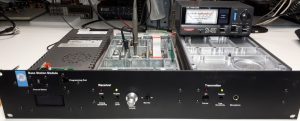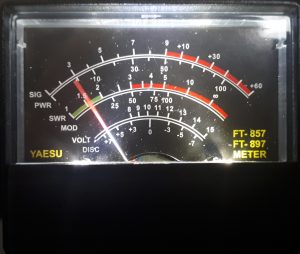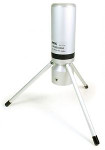 |
J’ai sauvé in-extremis une poignée de relais T800 Série II d’une fin de vie tragique chez le ferrailleur il y a quelques mois. Mon activité professionnelle ayant dépassé les limites de l’imaginable dans le même temps, je n’ai pas eu le temps de m’occuper de ce matériel, mais cela tend à se calmer, tout du moins suffisamment pour que je puisse commencer à m’en occuper sérieusement. J’espère donc pouvoir partager d’ici peu le résultat de mes essais et modifications sur ces équipements. |
Archives de l’auteur : Ludo
Conversion de postes Motorola GM1200 (3RP) en MC2100 (2RP)
Étant un peu perdu face à la diversité d’informations, pas forcément très détaillées et quelques fois divergentes, je vais à mon tour tenter de partager mon expérience suite à la conversion réalisée avec succès de deux GM1200. Une fois de plus, afin de ne pas rendre ces explications rédhibitoires avec la mise en page sommaire des publications sur le moteur de ce blog, j’ai décidé de rassembler toutes les informations dans un fichier PDF. Ce format permet un partage simplifié et une diffusion même en cas d’indisponibilité de mon serveur web.
J’espère que ma tentative de vulgarisation de cette procédure permettra à d’autres possesseurs de ces radios de connaitre le même succès dans cette opération. Dans le cas contraire, n’hésitez pas à laisser un commentaire à la suite de cette publication, avec le lien « Ajouter un commentaire » situé en bas de cette page.
Continuer la lecture
Soundfreaq SFQ-04 hack attempt – Help needed
 |
Has anyone successfully opened this device without breaking it into pieces? The only thing I was able to do so far is to remove the front top and bottom plastic cover, using a cutter blade as a lever. Then I’ve untightened the screws at the bottom of the speaker, but the ones at the top are covered with the speakers grille. This last one seems to be glued very well and I don’t see any way to get it off without risking to bend it. I cant imagine how this company can provide after sale service and servicing of faulty speakers, or I’m completely wrong about the disassembly procedure… |
Motorola Waris series S-meter
 |
Although the following design is not revolutionary at all, it still has the benefit of fulfilling its primary function and bringing back memories of electronics courses about op amps. Moreover, it does not need any specific measuring tool for the calibration process. You’ll need something to generate a strong RX signal though, like your kid’s PMR talkie-walkies, in order to set the full range signal reading. |
VNA Vs SA
 |
Just a few lines to share a quick VSWR measurement comparison between my MRS Mini VNA tiny and my Rigol DSA815-TG along with the VB1032. |
ALCATEL ATR42x, la résurrection!

De nombreuses personnes, dont certaines travaillaient à l’époque chez le constructeur, proposent déjà diverses solutions permettant de réutiliser ces postes « pro » sur les bandes radioamateur. Les logiciels embarqués qui sont utilisés donnent accès à des fonctions assez sommaires, et rendent l’utilisation de ces postes relativement inconfortable.
Ces bidouilles ont toutefois l’avantage d’exister et ont certainement permis à ces postes de ne pas finir leur vie chez le ferrailleur. Un autre avantage non négligeable est la mise à disposition des schémas qui auraient autrement eux aussi disparu, compte tenu dnumere l’age avancé de ces postes.
On pourrait se questionner sur l’intérêt de vouloir exhumer ce vieux matériel, dont les dates de fabrication s’étendent de 1988 à 1994 d’après les plaques d’identification des postes dont je dispose. Pour le commun des mortels, la réponse est simple : aucun. D’autres fabricants proposent des postes beaucoup plus évolués, donnant accès à une bande de fréquences nettement plus large sans nécessiter de modification matérielle hasardeuse, et permettant même de s’adonner aux communications numériques, sans avoir à « réinventer la roue » pour être utilisés hors de leur domaine initial. Mon avis en tant qu’écouteur est un peu plus mitigé, notamment lorsqu’il s’agit de balayer toute une plage de fréquence, sans trou. Les postes destinés à un usage professionnel ont leurs fréquences de fonctionnement programmées en dur, majoritairement à l’aide d’un logiciel propriétaire dont l’utilisation n’est pas intuitive, ce qui limite l’utilisateur à un certain nombre de fréquences accessibles, en fonction du nombre de canaux mémorisables. La souplesse de paramétrage dont l’utilisateur dispose sur les récepteurs ou postes radioamateur est, elle aussi, soumise à l’utilisation d’un PC.
Pourquoi donc s’attaquer au logiciel embarqué d’une si vieille gamme de postes dans ce cas ?
14/04/2025 : Ajout des schémas complets de l’ATR421, de l’ATR423 (une variante de celle mise en ligne ici fin 2017) et de l’ATR427, reconstitués à partir de manuels de maintenance scannés.
26/04/2025 : Ajout du schéma complet de l’ATR 9213 MB SCR.
27/04/2025 : Ajout du tableau répertoriant l’ensemble des plans et schémas que j’ai en ma possession, avec les liens de téléchargement des documents.
Les liens vers ces nouveaux schémas sont ci-dessous.
Si vous vous posiez la question : le logiciel alternatif que j’entendais créer n’a pas abouti à quoi que ce soit d’exploitable. Ceci étant dit, j’ai eu recours à l’aide de ChatGPT pour d’autres projets et j’ai été bluffé par la qualité des réponses, ainsi que par le code fourni. Il faut constamment vérifier son code, parfois bien buggé, mais ça aide pas mal sur des sujets compliqués comme ceux qui m’ont rapidement découragés pour le logiciel alternatif de l’ATR42x.
Enfin, je reprends l’analyse effectuée par retro-ingénierie pour me rafraîchir la mémoire, et j’avoue avoir du mal à comprendre ce que j’ai écrit à certains moments. Je vais aussi remanier le document consignant cette analyse, pour rendre les choses moins compliquées à lire. Les détails techniques pointus seront conservés, car toujours utiles quoi qu’il en soit.
Continuer la lecture
Helping the TYT MD380 charger go green.
 |
If you came here hoping to charge your MD380 faster, you just fell into a trap! By the way, you can still read the few following lines as this may still interest you . |
Aliexpress’s bargains – S01E01
 |
In this episode of Aliexpress’s bargains, I’ll write a few words about what’s sold as a Nagoya UT-108UV. I don’t delude myself, what I bought is certainly just a bad copy of a terrible clone, but whatever… The first thing I did after opening the bubble wrap package was to unbend the nicely curved antenna, then plug it to the VNA and see how horrible it could be, and I can’t say I’ve been deceived by what I saw… |
Sirio GP430LB autopsy
 |
If you ever wondered what’s inside a GP430LB or how wide is this antenna’s bandwidth, you’ve come to the right place. |
Diamond X50N to X50NA: Cut it three times and still too short!
 |
This short article describes how I shortened my X50N in order to get a better reception on 446MHz.
This antenna was bought from Wimo’s website, so I’ll consider it as an genuine antenna from Diamond (not one of its numerous and probably bad clones). |